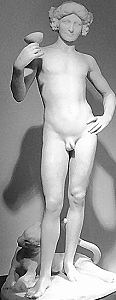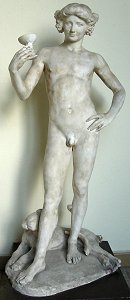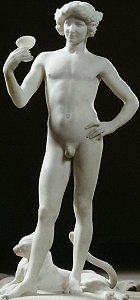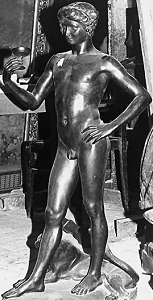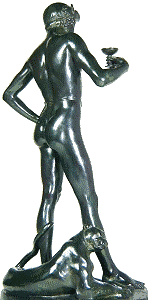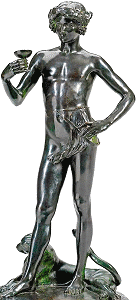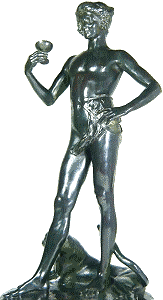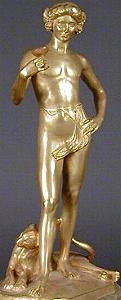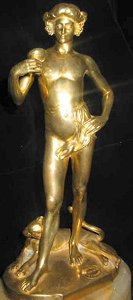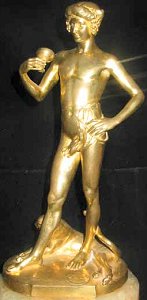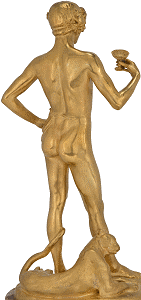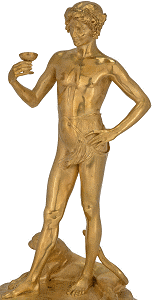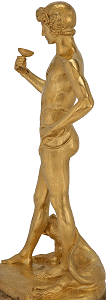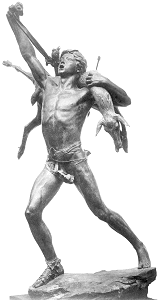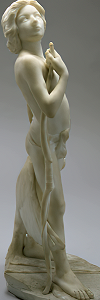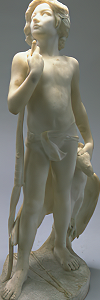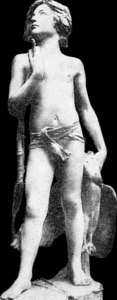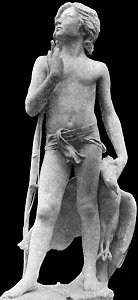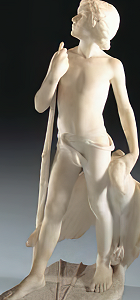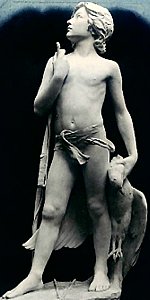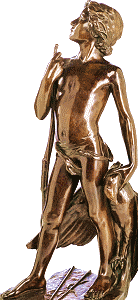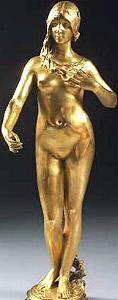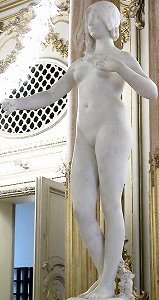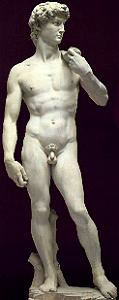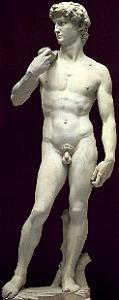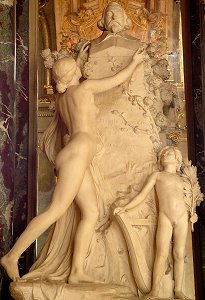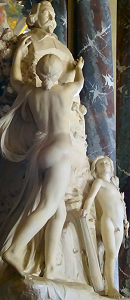
Site Introduction | Art Gallery Index | View Pictures
![]() Jean Antonin Carlès
Jean Antonin Carlès
(1851-1919)
Various Works
Updated 1 June 2017
I found a biography of this artist on a French site (now apparently defunct):
Antonin Carlès [1851-1919] est un sculpteur gimontois, qui fit une belle carrière nationale, et même internationale (on lui doit les Muses de l'immeuble du Herald Tribune, à New York). Le petit guide du musée des Jacobins lui attribue à tort le prix de Rome, qu'il n'a jamais obtenu; mais ce lapsus est significatif, et il aurait bien mérité la villa Médicis. Il est académique et compétent. Son contemporain Rouméguère [Auch 1863-1925], peintre paysagiste, est moins académique, lui, mais hélas beaucoup moins compétent. Si l'on ne faisait qu'entendre parler de ses oeuvres, sans les voir, on aurait aussitôt un préjugé très favorable, à leur égard. Comme Seurat, il s'est beaucoup intéressé aux lois de l'optique, et à la chimie des couleurs; dentiste et fils de dentiste, il préconisait une "peinture scientifique". Comme Monet il avait la passion des Phases de la lumière.. C'est même là le titre de la plus intéressante parmi ces entreprises, une suite de dix petits tableaux censés capter l'évolution du jour sur des paysages pyrénéens, de l'aube au crépuscule. Ils ne sont intéressants, malheureusement, que comme idée. Dans un monde meilleur, où serait enseigné vraiment l'art de voir, on pourrait se servir de Rouméguère pour expliquer aux écoliers ce que c'est qu'un mauvais peintre. Ses intentions sont toujours excellentes, sa peinture ne décolle jamais. Sa touche est morne, sa pâte est triste, sa couleur est toujours celle de ses tubes, jamais celle de l'air, et moins encore celle de l'art.
Google translation (oh, dear):
Antonin Carlès (1851-1919) is a Gimontish sculptor who has had a great national and even international career (the Muses of the Herald Tribune building in New York). The little guide of the Museum of the Jacobins wrongly ascribes to him the price of Rome, which he never obtained; But this slip is significant, and he would have well deserved the Villa Medici. He is academic and competent. His contemporary Rouméguère [Auch 1863-1925], landscape painter, is less academic, but unfortunately far less competent. If one only heard of his works, without seeing them, one would at once have a very favorable prejudice towards them. Like Seurat, he was much interested in the laws of optics, and in the chemistry of colors; Dentist and son of dentist, he advocated a "scientific painting". Like Monet, he had the passion for the Phases of Light. This is even the title of the most interesting of these companies, a succession of ten small paintings supposed to capture the evolution of the day on Pyrenean landscapes, dawn at dusk. Unfortunately, they are interesting only as an idea. In a better world, where the art of seeing would really be taught, Rouméguere could be used to explain to schoolchildren what a bad painter is. His intentions are always excellent, his painting never takes off. His touch is gloomy, his paste is sad, his color is always that of his tubes, never that of the air, and still less that of art.So... now you know as much as I do. The images link to bigger versions, although in most cases,
due to a frustrating lack of book or internet photos,
not much bigger...they’re just the biggest I could get!!!
(1, 2, 3, 4) Bacchanal: a sleek youth shows his suport for Bacchus, god of wine, by getting drunk,
while a panther lazes at his feet. Two nude versions in three marble and one bronze editions.
(7, 8, 9, 10) One dark and (11, 12, 13, 14, 15, 16, 17) three gilt bronze statuette versions of Bacchanal.
(Supersize photos of the third: 14s, 15s, 16s, 17s)
As usual in commercial reproductions, his genitalia are censored
by added drapery, although his buttocks remain naked.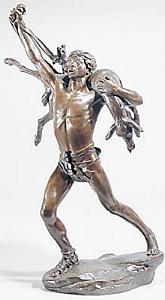
(18, 19) The Hunter, aka The Savage: the savage hunter triumphantly carries his kill home to
his tribe. The statuette version, left, again has more drapery than the full-size version.
(20, 21, 22, 23, 24, 25, 26, 27) A Boy of Gaul, aka Dans Les Gaules: the boy, seen in a similar pose to the Bacchanal’s (see below for comment on this) and with a similar ragged semi-loincloth to the hunter’s, seems to be a hunter himself, though not for the reason I’d previously thought. For decades I’d misinterpreted the bird behind him as a hunting hawk and the object in his hand as a sling, but recently on closer inspection I realised that the bird is actually his prey - a goose that he’s holding by the neck. Once I came to that realisation, I thought to myself, “how stupid can I get?” (No answers, please - I’m perfectly capable of finding that out for myself.)
Previously I’d only ever found one black and white picture of this statue in an ancient encyclopedia, but I’ve recently discovered another very small black and white image, as well as a few more contemporary photos and images of reproductions. According to the notes accompanying the small black and white picture the whereabouts of the original is unknown. Shame.
(28, 29) La Jeunesse: a study in youthful femininity in both bronze and marble versions.
As can be clearly seen from these comparisons, the poses of Carlès’ Bacchanal
and Boy of Gaul are both almost exact mirror-images of Michelangelo’s David.
Talk about imitation being the sincerest form of flattery!
Monument to the poet Pierre Goudouli; (30) , Flickr photo by Marie-Hélène Cingal;
(31) adjusted detail from Wikimedia Commons image.
Notice how the woman and boy look similar to the figures of Jeunesse and
Dans les Gaules. Long before environmentalism, artists practiced recycling.
Comment on this page
Site Introduction | Art Gallery Index | Return to Top of Page
